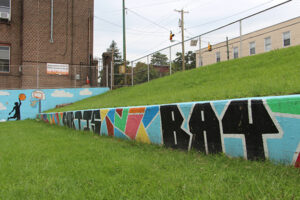 When Free Your Voice—a student-organized human rights group at the high school—learned about the incinerator, they recognized it as another incoming wave in the relentless tide of environmental injustice that had been battering their community for decades. After researching the incinerator and learning that the burning of its trash, which was imported from outside of Baltimore, would emit toxic pollutants into a community already known for extremely poor air quality, they took action. They canvassed their neighborhood informing residents of the public health threat. They spoke out at meetings and rallies. They informed and mobilized people at the institutions contracted to purchase energy from the incinerator. At one point, they went to the Maryland Department of the Environment, the agency that permitted the incinerator, and set up a peaceful protest that ended in the arrest of seven group members. All the while, they endured the cynicism of a disenfranchised community, threats from an Energy Answers official, and the pressures of papers, tests, and other realities of high school. But they persisted, and by February 2015, the BRCPC terminated its contract with Energy Answers. By June 2016, the incinerator’s permit was revoked.
When Free Your Voice—a student-organized human rights group at the high school—learned about the incinerator, they recognized it as another incoming wave in the relentless tide of environmental injustice that had been battering their community for decades. After researching the incinerator and learning that the burning of its trash, which was imported from outside of Baltimore, would emit toxic pollutants into a community already known for extremely poor air quality, they took action. They canvassed their neighborhood informing residents of the public health threat. They spoke out at meetings and rallies. They informed and mobilized people at the institutions contracted to purchase energy from the incinerator. At one point, they went to the Maryland Department of the Environment, the agency that permitted the incinerator, and set up a peaceful protest that ended in the arrest of seven group members. All the while, they endured the cynicism of a disenfranchised community, threats from an Energy Answers official, and the pressures of papers, tests, and other realities of high school. But they persisted, and by February 2015, the BRCPC terminated its contract with Energy Answers. By June 2016, the incinerator’s permit was revoked.
We were honored to have the opportunity to visit Curtis Bay with three members of Free Your Voice:
- Once a “shy girl” who barely spoke, Destiny Watford became one of Free Your Voice’s most outspoken leaders, and in 2016, she was awarded the Goldman Environmental Prize on behalf of the group. Today, she continues her work for Free Your Voice while studying communications at Towson University. She hopes to use her skills to help other communities tell their stories.
- Charles Graham was introverted, homeless, and suffering from depression when he joined Free Your Voice. Now referred to as the group’s “poet,” Charles aspires to become a community organizer. He is holding down a job while working with Free Your Voice to address Curtis Bay’s need for affordable housing, and he hopes to attend college in the future.
- Evan Maminski, one of the group’s youngest members, got involved when his mother proposed a solar farm for the 90-acre incinerator site. He is now the group’s technology guru, and he is working with Charles on the issue of affordable housing.
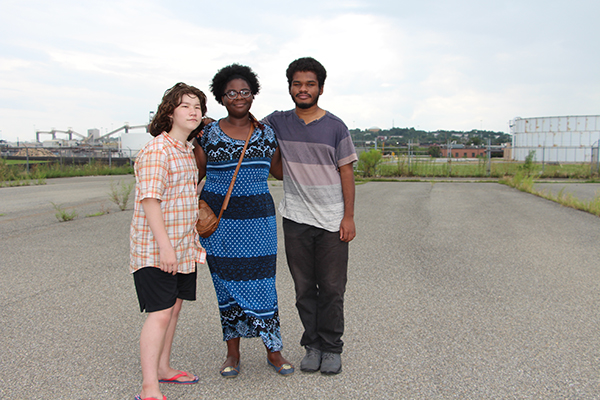
(L-R) Evan Maminski, Destiny Watford & Charles Graham of Free Your Voice
Tell us about Curtis Bay and what it’s like to live there.
Charles: Curtis Bay was founded in the late 1800s around shipbuilding, but up until the Industrial Revolution, the Fairfield/Wagner area of Curtis Bay—now the industrial peninsula—was primarily an agricultural community. Even during the Industrial Revolution, people could still go into their backyards and pick a pear. There were entire forests here. But by the late 1990s, industry had grown so much that pollution made conditions there unlivable, and people on the Fairfield peninsula—who were predominantly African American—were displaced.
Destiny: In Curtis Bay there is a dividing line. This community is under the heavy weight of poverty and we are surrounded by industry. People who live here are forced to deal with the very harsh reality that we are more likely to die of lung cancer or respiratory disease and to suffer from asthma just because we live, work, or go to school here. But on the other hand, parts of the area are thriving, and addressing some of the harsh realities we’re living in. For example, Curtis Bay is a food desert, but we have an amazing community garden that offers free eggs and fresh fruits and vegetables to community members at a very discounted price every Thursday.
What kinds of industry are located here?
Destiny: A coal pier, an auto terminal, the City’s landfill and wastewater treatment plant, and the nation’s largest medical waste incinerator.
Charles: There is also a lot of industry going on here that is hard to find information on. There is a lot more industry than we just mentioned, and we’re struggling to figure out what it all is.
Is Curtis Bay a community that was redlined?
Destiny: It was much worse than being redlined. We weren’t even considered for redlining, because the area was not considered to be “residential.” We were considered “industry.”
Charles: And that is still true today. When it comes to what happens in our neighborhood, we are left out of the conversation.
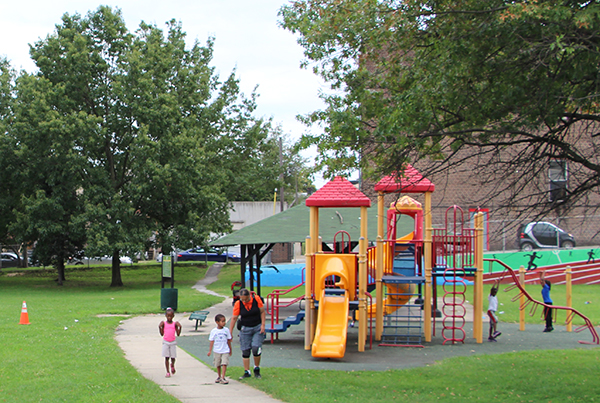
Industry has replaced the waterfront as the backdrop for the Curtis Bay neighborhood
In 2010, the state of MD approved plans for the nation’s largest trash incinerator to be built in Curtis Bay. How old were you then and what did you know about incinerators at the time?
Destiny: Yes, both the Governor and Mayor approved of the incinerator. I was a freshman in high school, and I didn’t even know what an incinerator was.
How did you go from not knowing anything to leading an effort to stop it from being built in your neighborhood? What inspired you to take action?
Charles: We had started a group called Free Your Voice, which was coming together every week to talk about human rights. At the time, we weren’t even sure what we wanted to focus on.
Destiny: We started by analyzing human rights, and thinking about what they look like in the world we live in, as well as in our own community. We saw that there was a lot of injustice in our neighborhood—everything from housing, to food injustice, to the environment.
Charles: An organizer from United Workers, a human rights organization (of which Free Your Voice ultimately became an extension) came to talk to us about the incinerator, and it really hit home for us. It was going to be built less than a mile from our school.
Destiny: We spent an entire year just researching. Once we found out more information, like the fact that the incinerator was going to burn 4,000 tons of trash every day and was projected to release 240 pounds of mercury and 1000 pounds of lead every year, it came to the point where we had to decide whether we were going to take it on. We were hesitant at first, because we weren’t all that confident in our skills and abilities as high school students, let alone as activists and artists. But one member of our group said, “If our group is fighting for human rights, and we don’t take on this incinerator, what are we? What’s the point?” That’s when we decided to reach out to our community members, residents, family members, and fellow students to tell them about the incinerator.
Charles: We also had a sense that doing this would, on some level, be fun.
You spent a lot of time canvassing your neighborhood. What were the main things that you discovered in that process about your neighbors and neighborhood?
Destiny: Only a handful of people we reached out to even knew about the incinerator. For the most part, once people learned about it, they were opposed to it. Some people were in support of it, and usually, that was because they felt like we needed jobs here. That gets into the older question of sacrificing health vs. needing to sustain yourself financially. That was one of the major tensions that has been in the community for a long time. Our history is that of a company town. The houses right behind us were built for people who would work in these industries.
Charles: Because of all the history that bombards anybody who tries to organize in a community like this, it very hard to change anything. We coined a phrase we used throughout the campaign: “the dumping ground mentality.” We constantly had to push back against that, particularly with a lot of our older community members.
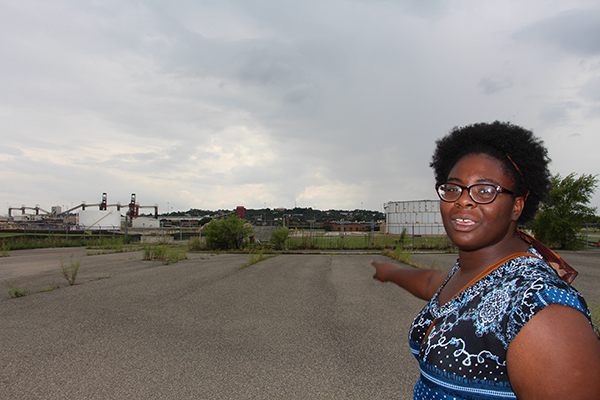
Destiny, at the site of the planned incinerator, points to her neighborhood in the distance
Tell me more about that.
Destiny: We approached this old man’s door, and told him about the incinerator and our fight to stop it. He basically told us that our work was pointless and that Curtis Bay will always be a dumping ground. To be perfectly honest, that hurt. But what he was saying was very true. It was coming from a place that was real because he had lived that history. That was an awakening moment for us because we realized that fighting the incinerator was going to take more than just spewing facts. It would take changing people’s mentality from a passive acceptance of the way things are to an active resistance in fighting the incinerator.
Did anyone not take you seriously because you were just teenagers?
Destiny: Being young was a double-edged sword. On the one end, we had great energy, and people respected that we were coming to do this work. But on the other edge, people were like, “Oh these are just some poor teenagers. Aren’t they cute?” There were some leaders in our district who said we were being manipulated by United Workers. They were like, “Oh you are being misinformed, you poor children.”
How did you get past that?
Charles: We just kept the ball rolling and didn’t let it stop us. We knew we had to be consistent.
In addition to consistency, what were some other keys to your campaign’s success?
Charles: The network we built up was very important. We found out there were public institutions throughout Maryland that were going to be buying energy from the incinerator. We began talking to people at those institutions and they didn’t know about the incinerator. The institutions were under contract to buy energy from the incinerator, but it was done through something called the Baltimore Regional Cooperative Purchasing Committee, which handles energy procurement for the City. That information didn’t have to go down to the people at these institutions.
Destiny: We also had facts on our side. The fact that the air people would breathe was going to be poisoned was pretty compelling.
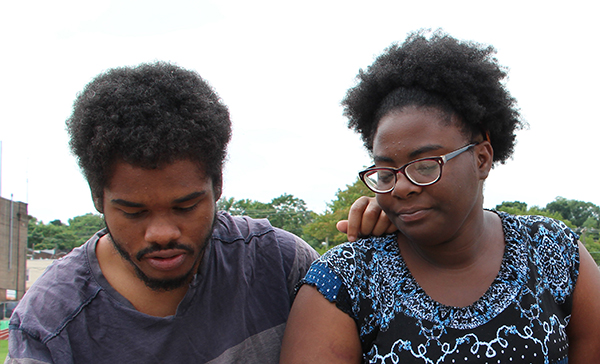
Charles, who was homeless when he became involved in Free Your Voice, found community in activism
Charles: Another key factor was our group itself. It felt real. There were points when our members would think very toxic thoughts. We would embrace that that was just where they were emotionally, and we would continue to interact with each other as humans.
Destiny: Free Your Voice was a place where we can talk very openly about our views of the world and have them be challenged but not shut down.
Outside of Free Your Voice, how did your peers react to what you were doing?
Charles: I was a part of the lazy, marijuana-smoking, skater crowd, and they didn’t really understand the significance of the issue. Any time I tried to nudge them toward joining the campaign and fighting the incinerator, they’d be like, “What? Are you gonna go box an incinerator?”
Destiny, your efforts earned you, on behalf of Free Your Voice, a Goldman Environmental Prize. What is this prize?
Destiny: The Goldman Environmental Prize is very prestigious. It is only given to six people in the world who are fighting against environmental injustice. I did not know the award was happening. I did not apply, Greg and other leaders from United Workers did.
Charles: At one point, the people from the Goldman Prize were calling Destiny to tell her she had won the award and she thought it was a scam.
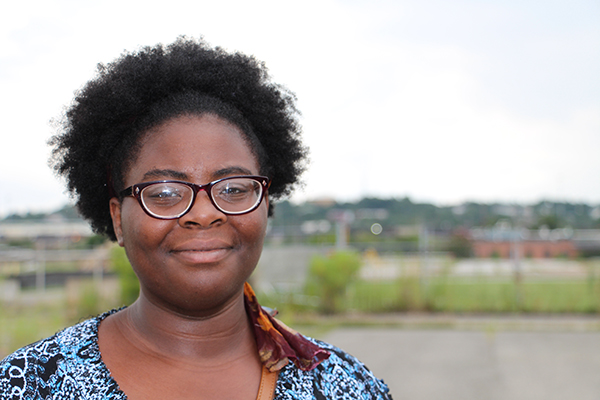
Goldman Prize winner Destiny Watford
Once you knew it was not a scam, what did winning the award mean to you?
Destiny: Winning this award, especially on behalf of our group, was a very proud moment. The other people who were awarded the Goldman Prize were doing amazing work: a man who essentially created land trusts for indigenous communities in Tanzania that covered hundreds of thousands of acres…a subsistence farmer in Peru who fought against a mining company that was trying to take her land and faced constant physical threat. These people were fueled by the same kinds of injustices we were facing here in Curtis Bay. To have that unity was incredible. But winning the prize was not the end. The work continues.
We know what you don’t want in your neighborhood. What DO you want in your neighborhood? What is Free Your Voice’s vision for Curtis Bay? For Baltimore?
Destiny: Our vision for the neighborhood is to have community control of the land beneath our feet, so we are now working on creating a land trust.
What else are you doing to advance that vision?
Evan: Once Free Your Voice joined with United Workers, our organization really exploded. We are doing a lot.
Destiny: Charles and Evan are working on a project to identify opportunities to create affordable housing in the community.
Charles: Working within our umbrella organization, United Workers, we recognized a need for housing that wouldn’t be the usual development paradigm of a private developer coming in and letting the houses run down. We want the community to take hold of property and say what they want there. This is a citywide effort, and we are spearheading the work in our section of the city. For example, in early July, a fire devastated several houses right behind us. [Note: The cause of the fire is still unknown, but there is speculation that it started in an abandoned house. The fire station is on the same block as the devastated houses, but because the station’s one engine was out on another call, response was delayed. There have also been reports of a non-working fire hydrant.] We are trying to figure out who owns these houses, what they want to do with them and if there is a method by which we can get involved.
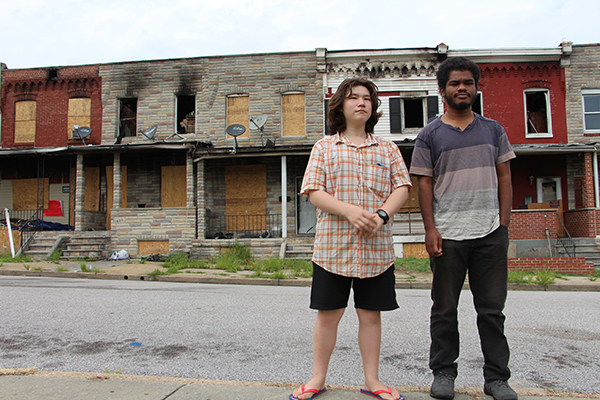
Evan and Charles at the site of a devastating fire
If we were to return to this section of burned out houses five years from now, what would you like to see here?
Destiny: I’d like to see housing created for people who want to stay and live here in a sustainable way. I see the community coming together and saying what they need, whether it is a grocery store, a park renovation, whatever. That would be a drastic break in the cycle of Curtis Bay’s history of developments coming in and doing whatever they want—at whatever price to the community. I want to change that cycle and give the power back to residents.
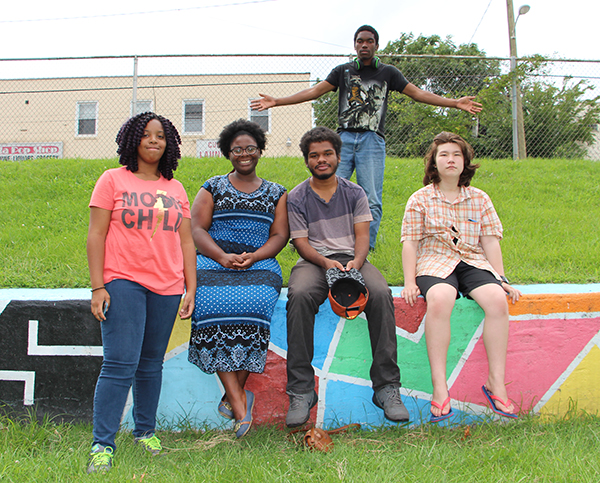
Destiny, Charles & Evan pose with Biohabitats summer interns Cameryn and Marcel
What advice do you have for our readers about the importance of including young people in discussions and decisions about projects in their communities?
Charles: It is important to make sure that kids have some idea of what the political spectrum looks like so they can engage in society in a critical way. Also, assume that kids are thinking, even if they don’t appear to be. A lot of kids cared about the incinerator, but they weren’t jumping at the opportunity to fight it simply because they were worried about living in poverty and having to work a full-time job.
Destiny: Engage them in a real way. Kids—whether young children or teenagers—are not stupid. For example, don’t just come into a school and tell kids not to throw litter on the ground. Talk about the issue of trash and tell them the reality of what is happening. Challenge them.
*Editor’s note: On September 18, a chemical leak occurred in Curtis Bay. Residents were told to shelter in place while hazmat crews cleaned up a leak of potentially lethal chlorosulfonic acid. If you share our concern for the residents of Curtis Bay, please consider supporting the efforts of United Workers (parent organization to Free Your Voice) to establish the Curtis Bay Community Land Trust.

